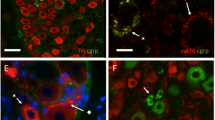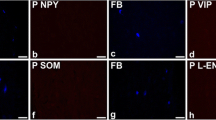Abstract
Micturition in the decerebrate cat is characterized by a coordinated bladder contraction and a simultaneous decrease in external urethral sphincter (EUS) efferent activity. Without the suppression of EUS activity, voiding is significantly impaired, resulting in a state sometimes referred to as bladder-sphincter dyssynergia. The aim of the present study was to determine whether glycinergic inhibition contributes to the suppression of EUS activity during micturition evoked by bladder distension or electrical stimulation of the pontine micturition center (PMC) in decerebrate cats. Using subconvulsive intravenous doses of strychnine (0.1–0.24 mg/kg), we examined changes in bladder and EUS electroneurographic (ENG) activity during micturition. Following subconvulsive doses of strychnine, tonic EUS ENG activity increased during bladder filling in five of six animals. In the presence of strychnine, it was possible to evoke reflex bladder contractions of similar duration and peak pressure to those observed before strychnine administration. However, there was an absence of suppression of EUS ENG activity during the bladder contractions in all the animals. To determine whether the changes in sphincter activity could be due to strychnine acting at glycine receptors on EUS motoneurons, sacral spinal tissue was processed for a structural protein (gephyrin) associated with the glycine receptor. Motoneurons in Onuf′s nucleus in S1 were identified using choline acetyltransferase immunohistochemistry and subsequently processed with a gephyrin monoclonal antibody. Abundant gephyrin labeling was evident throughout Onuf′s nucleus. Since Onuf′s nucleus is made up of EUS and other motoneuron populations, a sample of antidromically identified urethral and anal sphincter motoneurons were intracellularly labeled with tetramethylrhodamine dextran (TMR-D) and then processed with the gephyrin antibody. Using dual-beam confocal microscopy, gephyrin immunoreactivity was observed on the soma and proximal processes of individual EUS motoneurons in both male and female animals. It was concluded that a strychnine-sensitive mechanism contributes to the suppression of sphincter activity normally observed during voiding. Although glycinergic inhibition may affect several components of the circuitry responsible for micturition, it appears that the suppression of EUS motoneurons during micturition may be partly due to a direct glycinergic inhibition of the EUS motoneurons.
Similar content being viewed by others
Author information
Authors and Affiliations
Additional information
Received: 3 June 1997 / Accepted: 22 September 1997
Rights and permissions
About this article
Cite this article
Shefchyk, S., Espey, M., Carr, P. et al. Evidence for a strychnine-sensitive mechanism and glycine receptors involved in the control of urethral sphincter activity during micturition in the cat. Exp Brain Res 119, 297–306 (1998). https://doi.org/10.1007/s002210050345
Issue Date:
DOI: https://doi.org/10.1007/s002210050345




